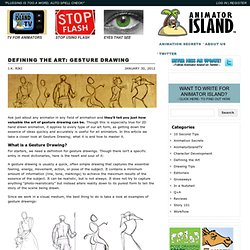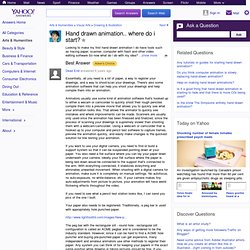

Defining the Art: Gesture Drawing. Ask just about any animator in any field of animation and they’ll tell you just how valuable the art of gesture drawing can be.

Though this is especially true for 2D hand drawn animation, it applies to every type of our art form, as getting down the essence of ideas quickly and accurately is useful for all animators. In this article we take a closer look at Gesture Drawing; what it is and how to master it. What is a Gesture Drawing? For starters, we need a definition for gesture drawings. Though there isn’t a specific entry in most dictionaries, here is the heart and soul of it: A gesture drawing is usually a quick, often simple drawing that captures the essential feeling, energy, movement, action, or pose of the subject. Since we work in a visual medium, the best thing to do is take a look at examples of gesture drawings: Though the gesture drawing examples above are all figures, gesture drawing isn’t limited to just the human form.
Emotions – building blocks of life. Emotions are the most important ingredients for narrative storytelling.

They are the driving factor for every human action – use them wisely and you can create believable and appealing characters that touch your audience. In this article we will have a look at what emotions are and why they are so important for every story. A part of human nature Emotions are the subjective intuitive side of our human nature. From a biological point of view, they are chemical and neurological events in our bodies that cause feelings, mood, and irrational impulses.
This is a constant polarity in our nature – as you may know, the brain is split into two hemispheres, which function in different ways: the left side is more objective and the right side, more subjective. Sometimes we feel emotionally balanced. In any case, a thought or an idea goes through an emotional evaluation – it could be a simple “what you do is right” feeling, a conflict, a rage, etc. – until it becomes an action Emotions = motivations.
Creating Real True Characters. It all started when I looked at my character and found that I knew nothing about her.

This put me on a journey to find out how to make my characters “Real” for myself. I found that this not only helped my animation, it improved my speed, solidified my poses, and gave me someone to animate with who is just as into the scene as I am. Here’s how I got to that point. I find myself reading a lot about how actors come up with characters. This is great reference to read but I find that half of what actors do doesn’t apply to animators or is just too time consuming for a few second clip.
Another problem I find with these acting books is that they always speak in the first person. I decided to start by diving into multiple thoughts of character development and trying to apply it to acting in animation. The puppeteer speaks to/about the character and an actor speaks as the character. Lets start with the masters of character at Pixar. Things to start your mind: 1. 2. 3. 4. 5. 6. 7. Animation Studio Stuff for Students: Animation Frame Capture - Video Capture.
I cover this topic in detail in the downloadable PDF booklet "Image Capture Techniques For Hand-Drawn Animation" which you can get by clicking on the link.

At the pencil test stage one option for getting your hand-drawn artwork into the computer is to capture your frames with a digital video camera mounted on a down-shooter (could be a sturdy tripod, but preferably a Copy Stand). Drawings meant to be digitized for final coloring should be captured using a scanner , which I'll discuss in the next article. The camera is pointed straight down at a shooting stage which has an Acme peg bar embedded or taped along the edge. The drawings are placed one at time under the camera and each drawing is captured as a single "frame" taken by the the animation software (i.e TVP or Digicel, etc.) via the live video feed from the camera. Digital video camera is attached to the computer via firewire (IEEE 1394) cable.
Testrite CS-3 copy stand being used for shooting pencil tests: 1.) 2.) 3.) 4.) Hand drawn animation.. where do i start. Essentially, all you need is a lot of paper, a way to register your drawings, and a way to shoot/scan your drawings.

There's also some animation software that can help you shoot your drawings and help compile them into an animation. Animators usually use some kind of animation software that's hooked up to either a wecam or camcorder to quickly shoot their rough penciles compile them into a preview movie that allows you to quickly see what your animation looks like. That allows the animator to quickly see mistakes and where improvements can be made.
Scanners are usually only used once the animation has been finessed and finalized, since the process of scanning your drawings is supremely slower than shooting them with a webcam/camcorder. Using a webcam or camcorder that is hooked up to your computer and pencil test software to capture frames, preview the animation quickly, and easily make changes is the quickest solution for line testing your animation.